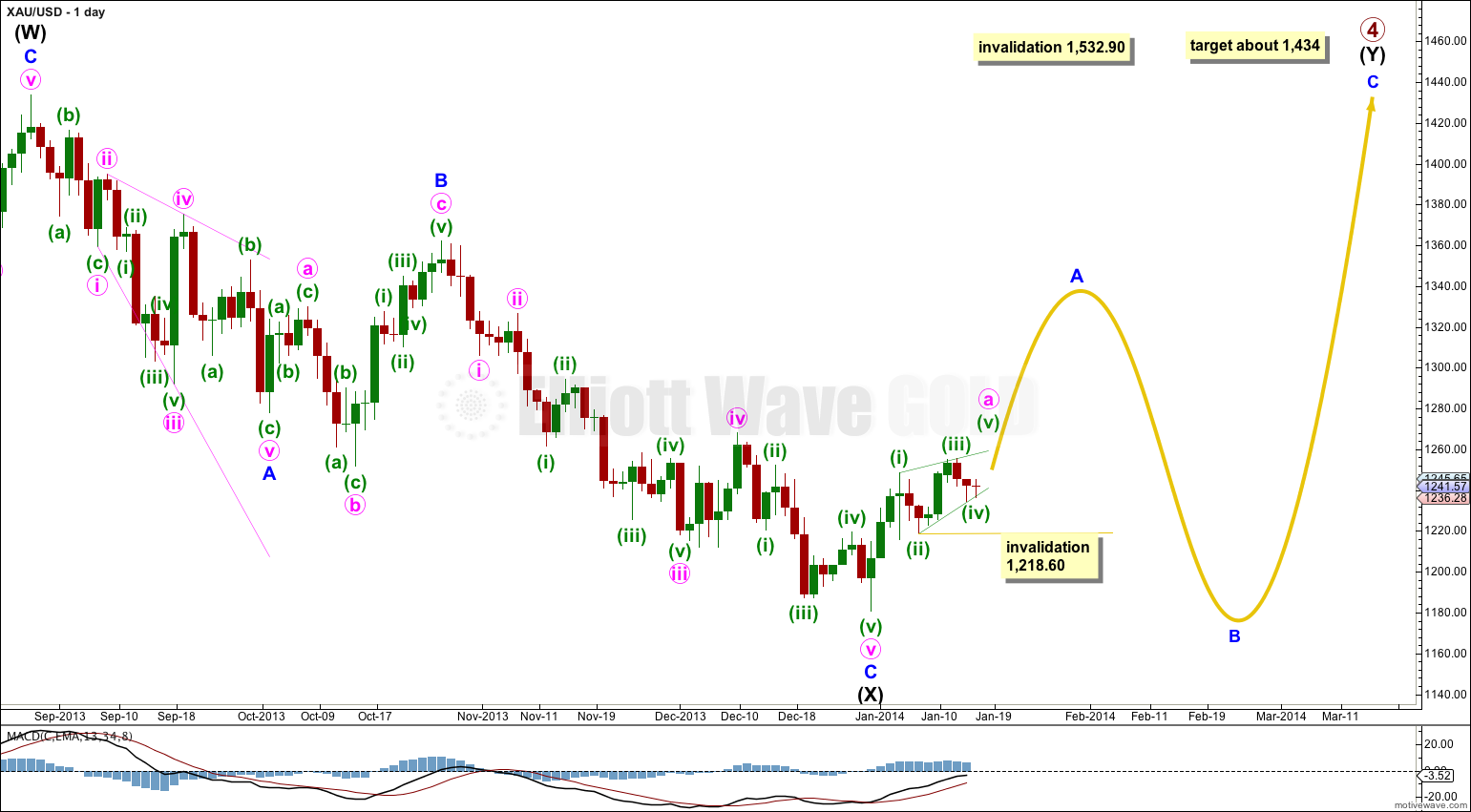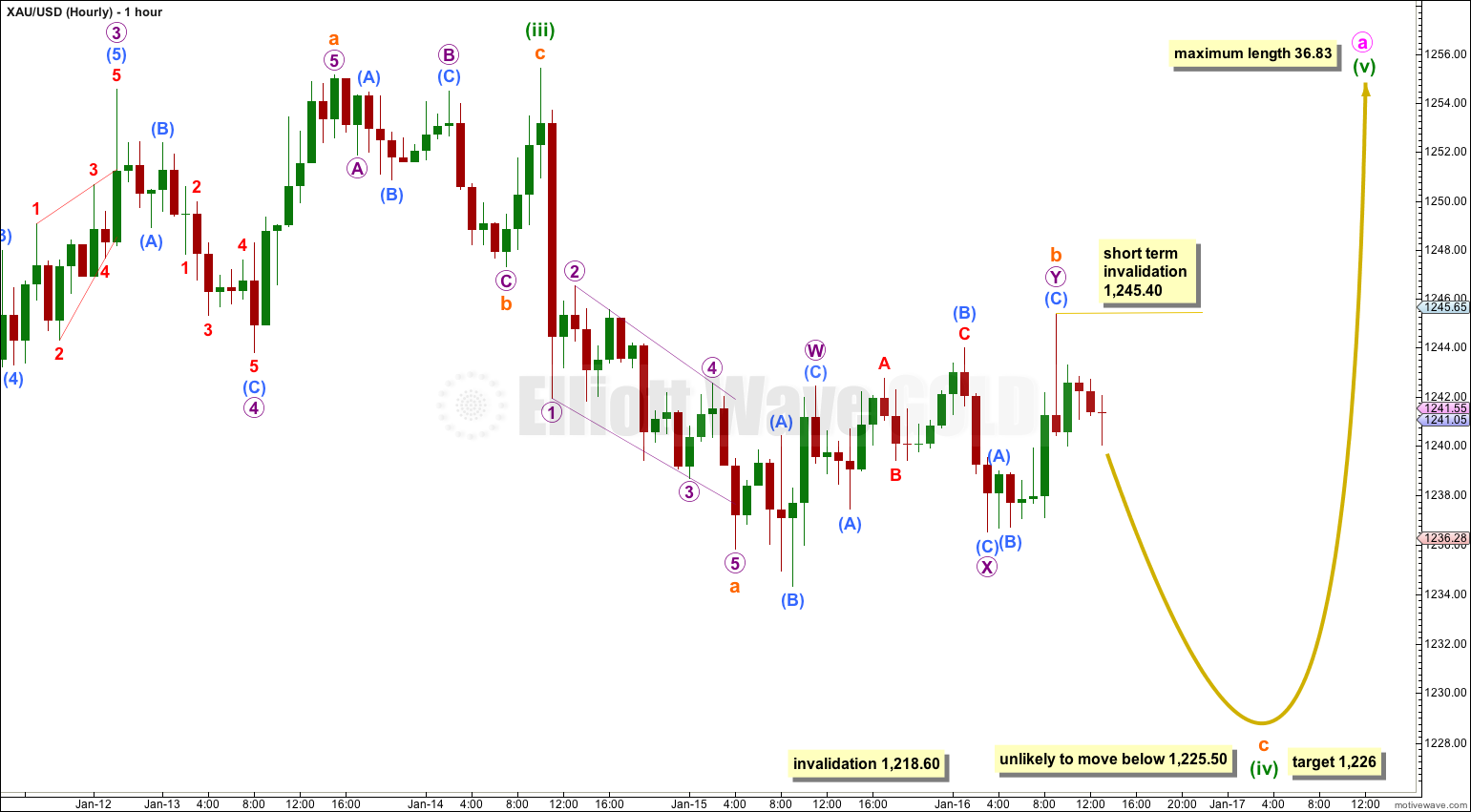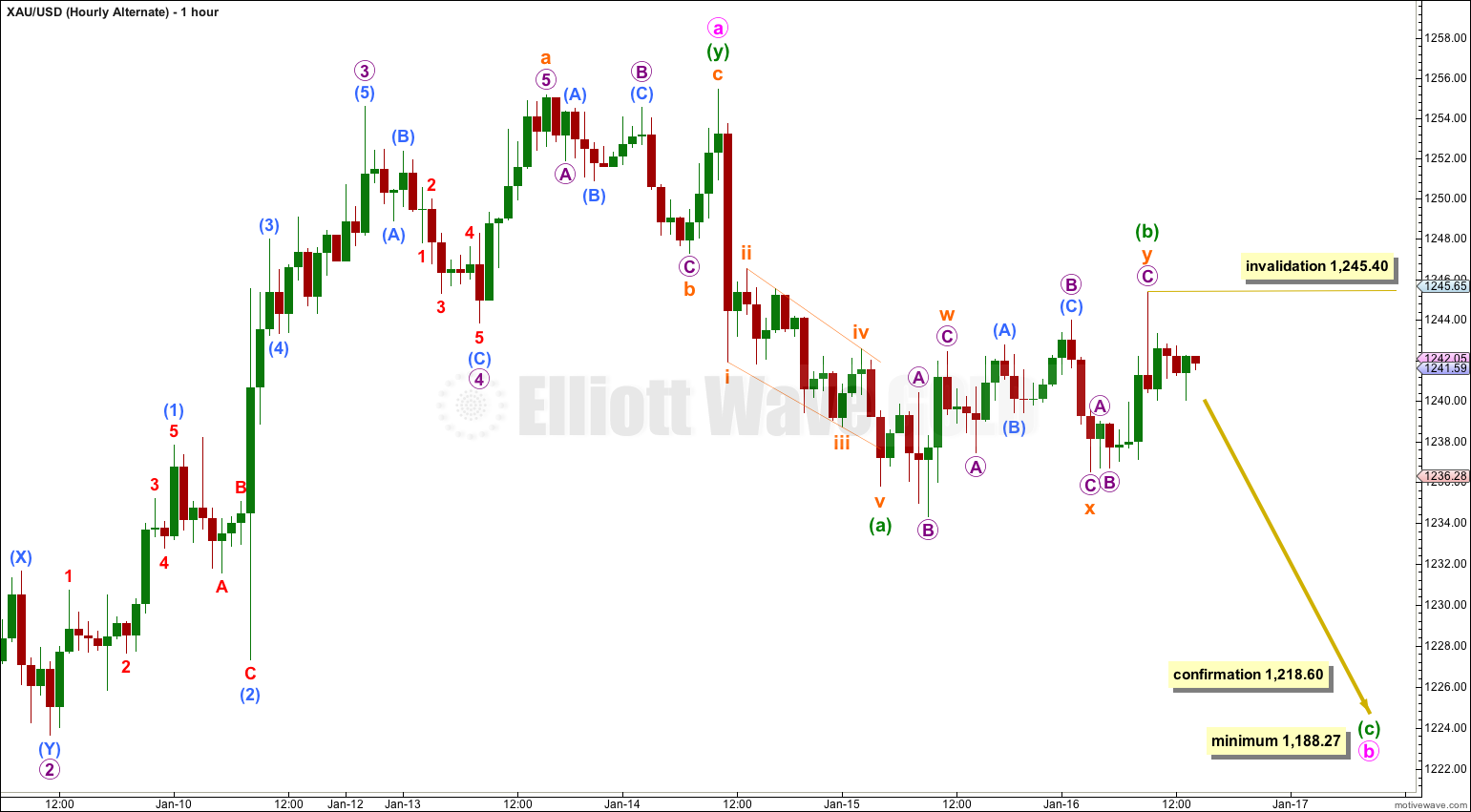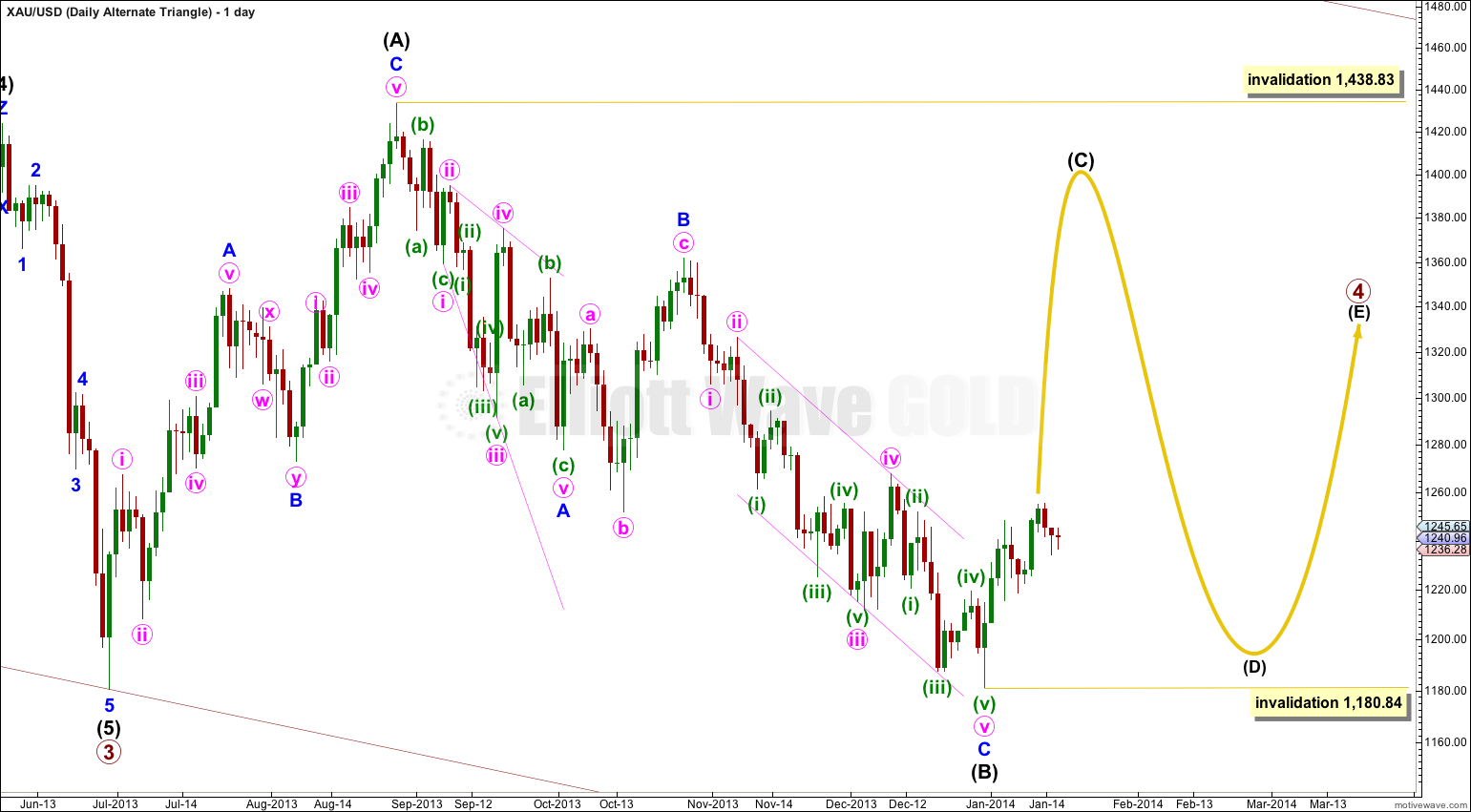Yesterday’s analysis expected a little upwards movement towards a short term target at 1,246 to be followed by downwards movement.
Price moved higher to reach 1,245.40. It may have turned there.
The next downwards wave was expected to be over by now but it is not.
Click on the charts below to enlarge.
Gold is still within a large fourth wave correction at primary wave degree which is incomplete. To see a full explanation of my reasoning for expecting that primary wave 4 is not over and is continuing see this.
Movement above 1,277.97 would provide confirmation that primary wave 4 is not over. At that stage upwards movement could not be a fourth wave correction within primary wave 5 because it would be in its first wave price territory, and the downwards movement labeled intermediate wave (X) would be confirmed as a completed three wave structure.
Primary wave 2 was a rare running flat correction, and was a deep 68% correction of primary wave 1. In order to show alternation in structure primary wave 4 may be a zigzag, double zigzag, combination, triangle or even an expanded or regular flat. We can rule out a zigzag because the first wave subdivides as a three. This still leaves several structural possibilities.
The downwards wave labeled intermediate wave (X) is now 99% the length of the upwards wave labeled intermediate wave (W). Primary wave 4 is most likely to be a combination or triangle in order to show structural alternation with the running flat of primary wave 2.
Primary wave 4 is unlikely to be a flat correction because if it were it would be a regular flat. These have similar behaviour and a similar look to running flats, and so there would be little structural alternation between primary waves 2 and 4.
Primary wave 4 is most likely to be a combination rather than a double zigzag because of the depth of intermediate wave (X). Double combinations take up time and move price sideways, and their X waves can be very deep. Double zigzags are different because their purpose is to deepen a correction when the first zigzag does not move price deep enough, so their X waves are not normally very deep. Thus intermediate wave (Y) is most likely to be a flat correction, and less likely a triangle and least likely a zigzag. It is most likely to end about the same level as intermediate wave (W) at 1,434 so that the whole structure moves sideways. It may last about 43 to 89 days, depending upon what structure it takes.
If intermediate wave (Y) is a flat correction then within it minor wave B must retrace a minimum of 90% the length of minor wave A, and it may make a new low below 1,180.84.
If intermediate wave (Y) is a flat correction then within it minor wave A must subdivide as a three wave structure. At this stage it looks like minor wave A may be unfolding as a zigzag because minute wave a within it looks like it is unfolding as a leading diagonal which is a five wave structure.
Primary wave 4 may not move into primary wave 1 price territory. This wave count is invalidated with movement above 1,532.90.
Within the leading diagonal minuette wave (iii) at 36.83 in length is shorter than minuette wave (i) which was 67.69 in length, so the diagonal is contracting.
Minuette wave (iv) should be shorter than minuette wave (ii). Minuette wave (iv) would reach equality with minuette wave (ii) at 1,225.50, but will most likely end before this price point.
Minuette wave (iv) must subdivide into a single zigzag. So far subminuette waves a and now b are most likely complete. Within subminuette wave c no second wave correction may move beyond its start. This wave count is invalidated in the short term with movement above 1,245.40.
Subminuette wave b is now extremely likely to be complete. It unfolded as a double combination: flat – X – zigzag. It has a small slope, it is not steep, and has a lot of sideways movement. While double combinations are common triples are extremely rare. Once the second structure in a multiple is completed the probability that the whole correction is complete is extremely high.
At 1,226 subminuette wave c would reach equality in length with subminuette wave a. I had expected subminuette wave c to be over by now but it is not. I would expect it to be over quite soon, most likely within the next day.
Minuette wave (iv) may not move beyond the end of minuette wave (ii). This wave count is invalidated with movement below 1,218.60.
Alternate Wave Count.
This wave count looks at the possibility that minor wave A is unfolding as a flat correction, and within it minute wave a was a double zigzag.
Within the flat correction minute wave b must correct downwards at least 90% the length of minute wave a, and it may make a new low below the start of minute wave a at 1,180.84.
The subdivisions for both wave counts are exactly the same. For this alternate downwards movement is also expected to continue, but it should continue for a few days yet and must reach 1,188.27 or below.
If the main wave count is invalidated with movement below 1,218.60 this alternate would be confirmed. At that stage I would expect more downwards movement to at least 1,188.27, and it would be fairly likely that price would make a new low below 1,180.84.
This wave count requires confirmation with movement below 1,218.60.
Alternate Daily Wave Count – Triangle.
It is also possible that primary wave 4 may continue as a regular contracting (or barrier) triangle.
The expected direction of this next upwards wave is the same, but for this alternate intermediate wave (C) of the triangle may not move beyond the end of intermediate wave (A). The triangle is invalidated with movement above 1,438.83.
Intermediate wave (C) must unfold as either a single or double zigzag. Within it no second wave correction, nor wave B of the zigzag, may move beyond the start of the first wave or A wave. This wave count is invalidated with movement below 1,180.84.
The final intermediate wave (E) upwards may not move above the end of intermediate wave (C) for both a contracting and barrier triangle. E waves most commonly end short of the A-C trend line.
All five subwaves of a triangle must divide into corrective structures. If this next upwards movement subdivides as a zigzag which does not make a new high above 1,438.83 then this alternate would be correct.
Triangles take up time and move price sideways. If primary wave 4 unfolds as a triangle then I would expect it to last months rather than weeks.






Lara, could this be minuette v up of the contracting diagonal and 1234.44 marked the end of minuette iv with some relabeling?
exactly.
I was a little unsure of my wave count yesterday, because that movement down to 1,234 is so very difficult to analyse. I’ve explained where I went wrong in the video of the 17th.
Lara, can this latest wave up be a wave 2 of a larger wave 3?
I’m not sure which time frame you’re referring to, or which wave degree.
If you mean this new upwards movement since 1,180.84, could that be the start of a third wave, the answer is no. That would see the first wave counterpart as the upwards wave labeled intermediate (W) and it subdivides as a three. First waves can only subdivide as fives.
To be more clear, I meant the move from the low on 15th Jan at 1233 as the possible start of wave 3 of a larger 3rd wave at Minute degree. Is it possible as per Fig 1-8 Frost & Prechter? 1181-1249 as 1st wave (a leading diagonal). 1249-1217 as 2nd wave. 1217-1255 as 1st wave of the 3rd wave. 1255-1233 as 2nd wave of 3rd wave.
One possible reason I see is that 1217-1255 did not clear the high of 1249 (but is surely still within the realms of possibility?). However, you have excluded from your analysis the possibility of the entire move from the low at 1181 being an impulse (albeit within a corrective structure at Intermediate degree). What have you seen which has made you exclude this as a possibility in your analysis that can give your readers the confidence that the move from 1233 isn’t the commencement of a powerful 3rd wave of 3? If you now consider it as even a slight possibility, what are the odds and why?